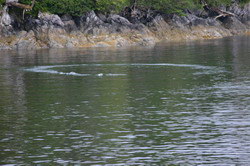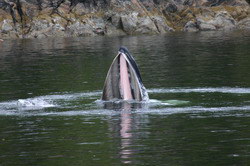Quite often we will observe one humpback whale following the shoreline with the intense purpose of feeding. Every 200 to 300 meters the whale will take a few shallow breaths, then arch its back to prepare for a deep dive. Our last sight is that of the tail fluke. Often others will join this whale and they will cooperate in an intriguing feeding strategy referred to as Bubble Net Feeding. The whales will  dive below a shoal of prey, approximately 50 meters, and then slowly they begin a spiral dance towards the surface, blowing bubbles in a circular motion. On the surface you will actually see a circle of bubbles form as the whales move in this spiral formation. The purpose of the bubbles is to congregate prey and force them towards the surface near the center of this circle. What you will witness next is an explosion of air as these whales surface in the center of this circle of bubbles, their mouths gaping wide open.
dive below a shoal of prey, approximately 50 meters, and then slowly they begin a spiral dance towards the surface, blowing bubbles in a circular motion. On the surface you will actually see a circle of bubbles form as the whales move in this spiral formation. The purpose of the bubbles is to congregate prey and force them towards the surface near the center of this circle. What you will witness next is an explosion of air as these whales surface in the center of this circle of bubbles, their mouths gaping wide open.  Humpback whales have 14 to 35 throat groves that run from chin to navel. These grooves facilitate the throat to expand. This expansion allows for large volumes of water and food into the mouth. As the mouth closes the whale will press down with its tongue forcing all water out through baleen plates. These baleen plates hang in row from each side of the upper jaw. Baleen is made of a similar protein to the human fingernail; they are very strong and flexible.
Humpback whales have 14 to 35 throat groves that run from chin to navel. These grooves facilitate the throat to expand. This expansion allows for large volumes of water and food into the mouth. As the mouth closes the whale will press down with its tongue forcing all water out through baleen plates. These baleen plates hang in row from each side of the upper jaw. Baleen is made of a similar protein to the human fingernail; they are very strong and flexible.
 Another method of feeding we often see with whales feeding alone is "Lunge Feeding". The whale will lunge through a shoal of prey with mouth gaping open often exploding at the surface with both food and water.
Another method of feeding we often see with whales feeding alone is "Lunge Feeding". The whale will lunge through a shoal of prey with mouth gaping open often exploding at the surface with both food and water.
Humpback whales do not feed in the warmer climates of Hawaii and Mexico so it certainly makes sense that once they arrive in their feeding grounds, this will occupy most of their time. They will feed on krill and various kinds of small, shoaling fish such as herring and mackerel. They may eat up to 1,400 kg of food a day.
While humpback whales feed, especially when it is a group effort, there will be an array of different calls from short grunts to long hollow calls.




 Humpback Feeding Behaviour
Humpback Feeding Behaviour